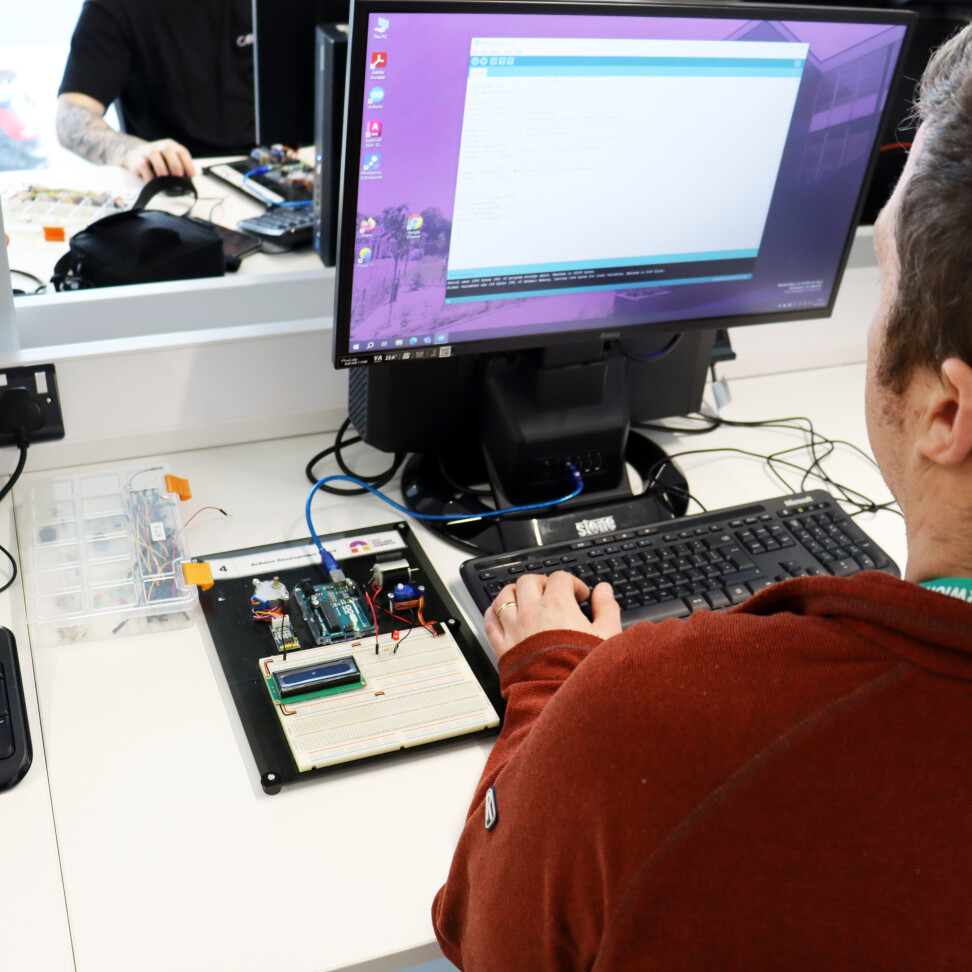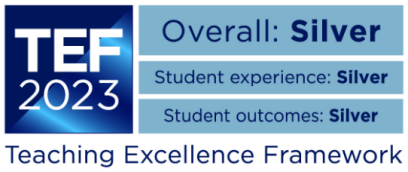HNC Electrical and Electronic Engineering for England (HTQ)

This qualification will equip you with the skills, knowledge and understanding to achieve high performance in the engineering and manufacturing environment. This course is perfect if you wish to develop your enquiring mind, and will allow you to grow the confidence and ability to work across different engineering functions. You will learn to lead, manage, respond to change and tackle a range of complex engineering situations.
- Level
- 4
- Entry Point
- Sep 2025
- Duration
- Part Time, 2 years
- Venue
- City College Norwich campus
- CCN Course Code
- G0064
Reasons to study
this course
The HNC in Electrical and Electronic Engineering for England allows you to develop as a professional, self-reflecting individual able to meet the demands of employers in the engineering sector and to adapt to a constantly changing world. The qualification aims to widen access to higher education and enhance the career prospects.
This qualification will provide you with the core skills required for a range of careers in engineering, specifically those related to electrical and electronic engineering. This course also offers a balance between employability skills and the knowledge essential for those with entrepreneurial, employment or academic ambitions. You will develop an understanding of the major impact that new digital software technologies have on the engineering environment, and will provide insight to electrical and electronic engineering operations and the opportunities and challenges presented by a global marketplace. You will be equipped with knowledge and understanding of culturally diverse organisations, cross-cultural issues, diversity and values.
Dr Dimitris Kakofengitis - Course Leader HNC Electrical and Electronic Engineering for England (HTQ)
This programme is designed to help you build the skills, knowledge, and confidence you need to succeed in the field of engineering. As your Course Leader, my main goal is to make sure you feel supported and motivated, helping you grow both personally and professionally. If you have any questions or need advice, I’m here to help.
Contact course leaderWhere will this
course take you?
Completing a HNC in Electrical and Electronic Engineering will equip you with the practical skills and theoretical knowledge for various career opportunities and pathways for further education. After obtaining your HNC, you could choose to pursue a Higher National Diploma (HND) in Electrical and Electronic Engineering, which delves deeper into the subject matter. Many universities also recognize the HNC qualification, allowing you to enter directly into the second year of a bachelor's degree program in a related field. This pathway enables you to attain a full honours degree with additional study.
Some career pathways include: Electrical Technician, Engineering Manufacturing Technician, Integration and Test Technician, Assistant Project Manager and Engineering Technician.
Course structure
This course is studied part time over one and a half years. This programme is delivered over one day a week - 30 teaching weeks per year. Employed students are expected to be granted one day off from work each week throughout the year.
Level 4 modules
Engineering Design Core
The tremendous possibilities of the techniques and processes developed by engineers can only be realised by great design. Design turns an idea into a useful artefact, the problem into a solution, or something ugly and inefficient into an elegant, desirable, and cost-effective everyday object. Without a sound understanding of the design process, the engineer works in isolation without the links between theory and the needs of the end user.
The aim of this unit is to introduce you to the methodical steps that engineers use in creating functional products and processes as an individual or part of a design team; from a design brief to the work, and the stages involved in identifying and justifying a solution to a given engineering need.
Among the topics included in this unit are: Gantt charts and critical path analysis, stakeholder requirements, market analysis, design process management, technical drawing, modelling and prototyping, manufacturability, sustainability and environmental impact, reliability, safety and risk analyses, and ergonomics.
On successful completion of this unit, you will be able to prepare an engineering design specification that satisfies stakeholders’ requirements, implement best practices when analysing and evaluating possible design solutions, prepare a written technical design report, and present their finalised design to a customer or audience.
Engineering Mathematics Core
The mathematics that is delivered in this unit is directly applicable to the engineering and manufacturing industry, and it will help to increase your knowledge of the broad underlying principles within this discipline.
The aim of this unit is to develop your skills in the mathematical principles and theories that underpin the engineering curriculum. You will be introduced to mathematical methods and statistical techniques in order to analyse and solve problems within an engineering and manufacturing context.
On successful completion of this unit, you will be able to employ mathematical methods within a variety of contextualised examples, interpret data using statistical techniques, and use analytical and computational methods to evaluate and solve engineering and manufacturing sector problems.
Managing a Professional Engineering Project Core
The responsibilities of the engineer go far beyond completing the task in hand. Reflecting on their role in a wider ethical, environmental, and sustainability context starts the process of becoming a professional engineer – a vital requirement for career progression.
Engineers seldom work in isolation and most tasks they undertake require a range of expertise, designing, developing, manufacturing, constructing, operating, and maintaining the physical infrastructure and content of our world. The bringing together of these skills, expertise, and experience is often managed through the creation of a project.
This unit introduces you to the techniques and best practices required to successfully create and manage an engineering/manufacturing project designed to identify a solution to an engineering need. While carrying out this project we will consider the role and function of engineering in our society, the professional duties and responsibilities expected of engineers together with the behaviours that accompany their actions.
Among the topics covered in this unit are: roles, responsibilities, and behaviours of a professional engineer, planning a project, project management stages, devising solutions, theories and calculations, management using a Gantt chart, evaluation techniques, communication skills, and the creation and presentation of a project report.
On successful completion of this unit, you will be able to conceive, plan, develop, and execute a successful engineering project, and produce and present a project report outlining and reflecting on the outcomes of each of the project processes and stages.
Production Engineering for Manufacture Compulsory
All of the manufactured products we use in our daily lives, from processed food to clothing and cars, are the result of production engineering. Production engineers need to have a comprehensive knowledge and understanding of all the possible production technologies available, their advantages and disadvantages, the requirements of the production system operation and the interaction between the various components of the production system.
This unit introduces you to the production process for key material types; the various types of machinery used to manufacture products and the different ways of organising production systems to optimise the production process; consideration of how to measure the effectiveness of a production system within the overall context of the manufacturing system; and an examination of how production engineering contributes to ensuring safe and reliable operation of manufacturing.
On successful completion of this unit, you will be able to learn about the role and purpose of production engineering and its relationship with the other elements of a manufacturing system; most appropriate production processes and associated facility arrangements for manufacturing products of different material types; and designing a production system incorporating a number of different production processes.
Automation, Robotics and Programmable Logic Controllers Compulsory
The word automation was not used until the 1940s and it originated in the automotive manufacturing sector as a method designed to reduce labour costs and improve the quality, accuracy and precision of the finished products. We are all now very familiar with the sight of dancing robots, not only in the production of cars but in everything from washing machines to pharmaceuticals. As a result of this technology the products we purchase may have never been touched by human hands and we all benefit from a reduction in costs and improvement in quality.
The aim of this unit is for you to investigate how Programmable Logic Controllers (PLCs) and industrial robots can be programmed to successfully implement automated engineering solutions. Among the topics included in this unit are: PLC system operational characteristics, different types of programming languages, types of robots and cell safety features.
On successful completion of this unit, you will be able to learn about programming PLCs and robotic manipulators to implement a set of activities, different types and uses of PLCs and robots available, writing PLC programs using a language of their choice, and program industrial robots with straightforward commands and safety factors.
Quality and Process Improvement Compulsory
Quality has always been the key to business success and survivability, but it requires organisations to allocate a lot of effort and resources to achieve it. The key to providing quality services and designing top quality products lies in the strength and effectiveness of the processes used in their development; processes which must be constantly reviewed to ensure they operate as efficiently, economically and as safely as possible.
This unit introduces you to the importance of quality assurance processes in a manufacturing or service environment and the principles and theories that underpin them. Topics included in this unit are: tools and techniques used to support quality control, attributes and variables, testing processes, costing modules, the importance of qualifying the costs related to quality, international standards for management (ISO 9000, 14000, 18000), European Foundation for Quality Management (EFQM), principles, tools and techniques of Total Quality Management (TQM) and implementation of Six Sigma.
On successful completion of this unit, you will be able to illustrate the processes and applications of statistical process, explain the quality control tools used to apply costing techniques, identify the standards expected in the engineering environment to improve efficiency, and examine how the concept of Total Quality Management and continuous improvement underpins modern manufacturing and service environments.
Electrical and Electronic Principles Compulsory
Electrical engineering is mainly concerned with the movement of energy and power in electrical form, and its generation and consumption. Electronics is mainly concerned with the manipulation of information, which may be acquired, stored, processed or transmitted in electrical form. Both depend on the same set of physical principles, though their applications differ widely. A study of electrical or electronic engineering depends very much on these underlying principles; these form the foundation for any qualification in the field, and are the basis of this unit.
The physical principles themselves build initially from our understanding of the atom, the concept of electrical charge, electric fields, and the behaviour of the electron in different types of material. This understanding is readily applied to electric circuits of different types, and the basic circuit laws and electrical components emerge. Another set of principles is built around semiconductor devices, which become the basis of modern electronics. An introduction to semiconductor theory leads to a survey of the key electronic components, primarily different types of diodes and transistors.
Electronics is very broadly divided into analogue and digital applications. The final section of the unit introduces the fundamentals of these, using simple applications. Thus, under analogue electronics, the amplifier and its characteristics are introduced. Under digital electronics, voltages are applied as logic values, and simple circuits made from logic gates are considered.
On successful completion of this unit you will have a good and wide-ranging grasp of the underlying principles of electrical and electronic circuits and devices, and will be able to proceed with confidence to further study.
Electrical Machines Compulsory
Electrical machines are used to convert electrical energy to and from mechanical energy. These are found in manufacturing, transport, consumer appliances, medical and other sectors. People will come across them every day in their home and at work. Electric machines are bidirectional electromechanical energy conversion devices that can be looked in two ways; as a motor which converts electrical energy to mechanical energy; or as a generator which converts mechanical energy to electrical energy. Transducers and actuators are also energy converters and can be found in a wide range of industrial and domestic applications.
This unit introduces you to the construction, modelling and characteristics of a range of electromagnetic machines and their practical application. Among the topics included in this unit are: principles underlying the operation and construction of brushed DC, induction, and synchronous machines (motors and generators), electromagnetic transducers and actuators; and operating characteristics of electrical machines such as voltage, current, speed, torque, power rating, electromagnetic interference (EMI) and efficiency.
On successful completion of this unit, you will be able to gain knowledge and understanding of the operating characteristics of different types of electrical machines and their practical applications in the industry.
Course details
Assessment methods
Your assignments will reflect the wide range of skills and knowledge developed throughout the course, and will aim to target particular industry-specific skills. An assignment may take a variety of forms, including practical and written.
Awarded by
This course is awarded by Pearson and regulated by The Office for Students.


Entry requirements
You will need at least one of the following:
GCSEs
- Grade C/4 or above in Mathematics and English (or equivalent)
A Levels
- At least one A Level in a relevant subject (e.g., Mathematics, Physics, or Engineering)
BTEC
-
Level 3 Diploma or Extended Diploma in Engineering or a similar field
NVQ
-
NVQ Level 3 or equivalent in a related subject
Recognition of Prior Learning (RPL) / Accreditation of Prior Learning (APL)
RPL/APL applicants with relevant industry experience or prior learning (without formal qualifications) may also be accepted. This is assessed on a case-by-case basis, where:
-
You must provide evidence of prior experience, such as a portfolio, references, or certifications
Mature Students
Many institutions are open to mature students who lack formal qualifications but have substantial work experience in electrical or electronic engineering. An interview or skills assessment might be required to evaluate your suitability.
International Applicants
If you are an international applicant, you will need:
-
Proof of equivalent qualifications from your home country
-
Demonstration of English language proficiency (e.g., IELTS with a score of 5.5 or higher, depending on the institution)
Course fees
£6,720 total for UK students.
£8,120 total for international students (students from outside of the UK).
Pearson Registration Fee
In addition to the course fees, there is also a Pearson registration fee, which they have not yet set for 2024/25, which will be charged separately to the tuition fees above.
As a guide, the 2023/24 BTEC Level 4 and 5 Higher National Student Registration (HTQ HNCs) fees were £259.75, in year one, with a further £23.00 learner registration in each subsequent year of study.
We were awarded a TEF Silver rating overall in 2023, achieving this for both student experience and student outcomes.

Search courses
Search CCN HE



